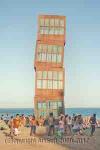Rebecca Horn
Rebecca Horn
Estilo: Conceptual Art;
Lugar: Michelstadt
Nascido: 1944
Biografia:
Rebecca Horn is a German visual artist, who is best known for her installation art, film directing, and her body modifications such as Einhorn (Unicorn), a body-suit with a very large horn projecting vertically from the headpiece. She directed the films Der Eintänzer (1978), La ferdinanda: Sonate für eine Medici-Villa (1982) and Buster's Bedroom (1990). Horn presently lives and works in Paris and Berlin.
Rebecca Horn was born on 24 March 1944 in Michelstadt, Germany. She was taught to draw by her Romanian governess and became obsessed with drawing with expression because it was not as confining or labeling as oral language. Living in Germany after the end of World War II greatly affected the liking she took to drawing. "We could not speak German. Germans were hated. We had to learn French and English. We were always traveling somewhere else, speaking something else. But I had a Romanian governess who taught me how to draw. I did not have to draw in German or French or English. I could just draw."
Horn spent most of her late childhood in boarding schools and at nineteen rebelled against her parents' plan of studying economics and decided to instead study art. In 1963 she attended the Hochschule für bildende Künste Hamburg (Hamburg Academy of Fine Arts). A year later she had to pull out of art school because she had contracted severe lung poisoning. "In 1964 I was 20 years old and living in Barcelona, in one of those hotels where you rent rooms by the hour. I was working with glass fibre, without a mask, because nobody said it was dangerous, and I got very sick. For a year I was in a sanatorium. My parents died. I was totally isolated."
After experiencing this isolation until she felt that her life was over before it had begun, she walked out of the hospital.[citation needed] The experience gave her a heightened sense of sensory awareness which she began to reflect upon in her early performances . She was still too ill, however, to resume life as a student or work with fiberglass and polyester. She had to take masses of antibiotics and sleep long hours to have enough energy to operate normally.[citation needed] She could, however, work with softer materials, and when in bed she drew with colored pencils, which are still her favorite drawing tools. She also began to slowly break out of her self-imposed isolation and began to create sculpture and strange extensions with balsa wood and cloth. "I began to produce my first body-sculptures. I could sew lying in bed." Her goal then was to quash her "loneliness by communicating through bodily forms."[citation needed]
Horn lived in Hamburg until 1971, in London for a brief time (1971–2), and since 1973 has lived in Berlin.
Horn is one of a generation of German artists who came to international prominence in the 1980s. She practices body art, but works in different media, including performance art, installation art, sculpture, and film. She also writes poetry. Sometimes her poetry is influenced by her work, and on many occasions it has inspired her work. When Horn returned to the Hamburg academy she continued to make cocoon-like things. She worked with padded body extensions and prosthetic bandages. In the late sixties she began creating performance art and continued to use bodily extensions.
In 1968 Horn produced her first body sculptures, in which she attached objects and instruments to the human body, taking as her theme the contact between a person and his or her environment. Einhorn (Unicorn) is one of Horn’s best known performance pieces: a long horn worn on her head, its title a pun on her name. She presented Einhorn at the 1972 Documenta. Its subject is a woman who is described by Horn as "very bourgeois", "21 years-old and ready to marry. She is spending her money on new bedroom furniture". She walks through a field and forest on a summer morning wearing only a white horn protruding directly from the front of the top of her head, held there by straps. These straps are almost identical to the ones in Frida Kahlo's painting Broken Column. The image, with wheat floating around the woman's hips, is simultaneously mythic and modern.
Pencil Mask is another body extension piece, made up of six straps running horizontally and three straps running vertically. Where the straps intersect a pencil has been attached. When moving her face back and forth on a near a wall the pencil marks that are made correspond directly with her movements.
Finger Gloves is a performance piece and the main prop of that performance piece and was done in 1972. They are worn like gloves, but the finger form extends with balsa wood and cloth. By being able to see what she was touching and the way in which she was touching it, it felt as if her fingers were extended and in her mind the illusion was created that she was actually touching what the extensions were touching. There is another piece that she did that is very similar to this one. It is part of her Berlin Exercises series done in 1974 called "touching the walls with both hands simultaneously". In this piece she made more finger extension gloves, but this time measured it so that they specifically fit the selected space. If the chosen participant stood in the middle of the room, they could exactly touch opposing walls simultaneously.
More...
Wikipedia link: Click Here













